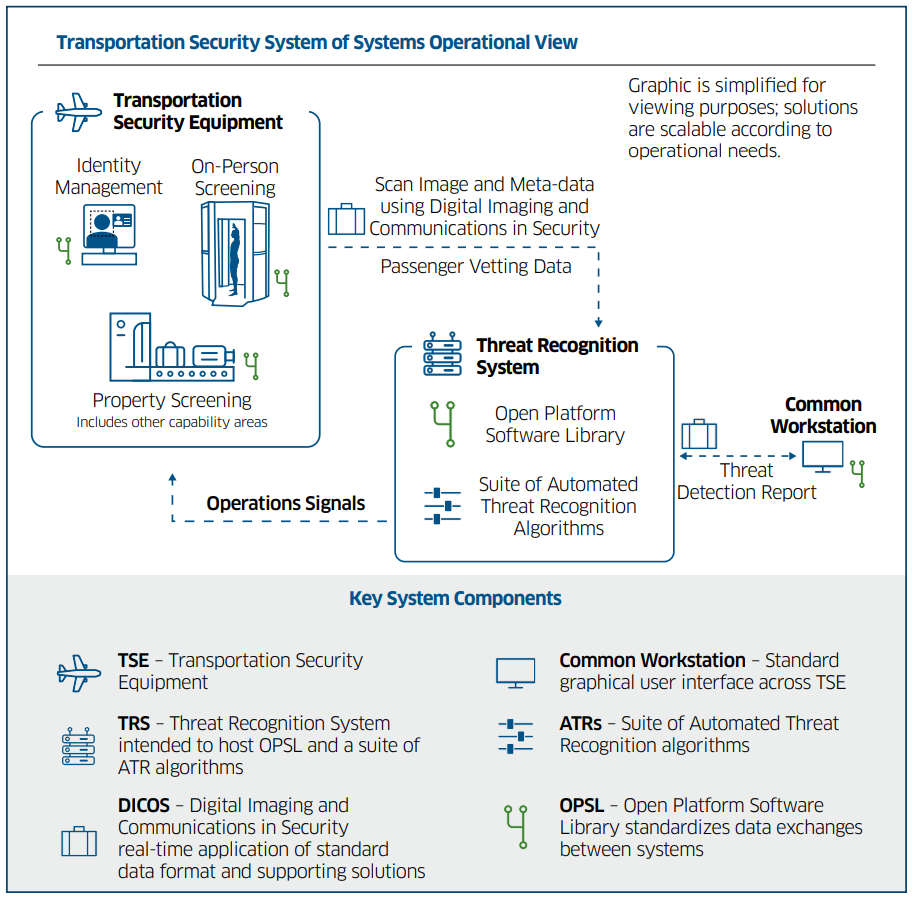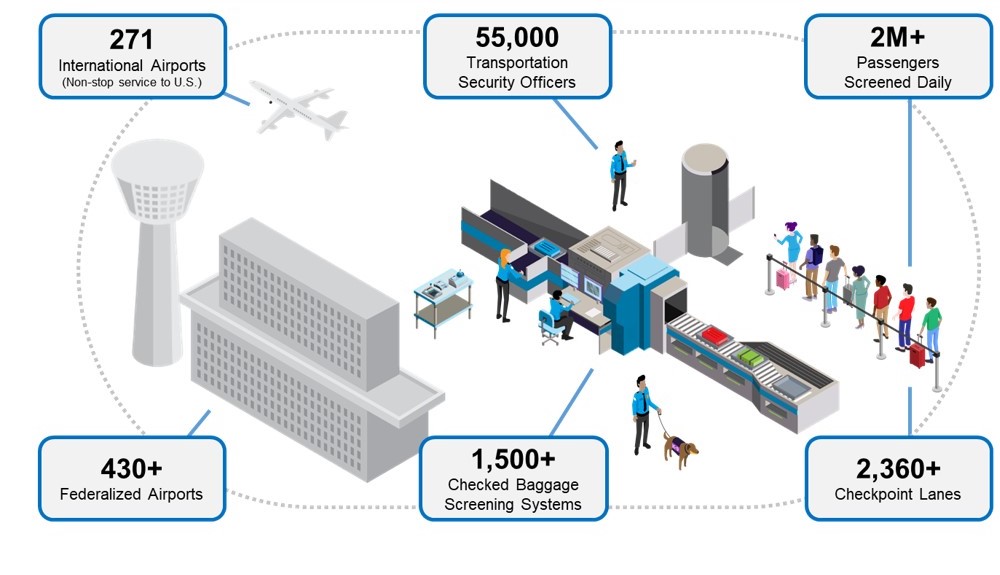The aviation industry is navigating through an era of unprecedented change, with technological innovations and regulatory standards steering the course of air travel and safety into the future. This evolution underscores the critical importance for companies, both new entrants and established players, to embrace key elements of Open Architecture (OA), such as the Digital Imaging and Communications in Security (DICOS) and the Open Platform Software Library (OPSL). Adopting these standards is not merely a technological upgrade; it represents a strategic pivot essential for thriving in the competitive and fast-paced aviation marketplace. An entire industry opportunity is opening up on the horizon for new (and proven!) technology to enter the aviation security sector. The goal is simple: making skies safer while improving the passenger experience. The TSA has boldly stepped forward by championing both DICOS and OPSL and including integration of these software suites into the next procurement cycles, signaling to the industry its commitment to an interoperable security solution.
Decoding DICOS and OPSL: Pillars of Modern Aviation Security
-
DICOS: At its core, DICOS is an innovative open standard file format that revolutionizes the way security imaging and information are shared and preserved across diverse airport security ecosystems. Its significance cannot be overstated—it's a game-changer in enhancing interoperability and streamlining operations, enabling different security systems to communicate seamlessly and exchange data without the usual barriers. This standard is instrumental in not just augmenting efficiency but also in bolstering the global aviation security framework. Based on the medical field's DICOM file format, DICOS is the standardized file format of choice for TSA (as well as many global airports and regulators) to allow the wide array of hardware and software solutions to speak the same language.
-
OPSL: Similarly, OPSL stands as a cornerstone for the integration and communication between hardware and software in aviation security systems. It lays down a robust framework for systems to interact and collaborate, sharing information fluidly and securely. This capability is foundational to maintaining the utmost safety standards and deploying state-of-the-art solutions that address the complex challenges faced by the aviation industry today. Where DICOS files contain the information of the various devices, OPSL establishes standardized connection points to allow those devices to transmit to one another while simultaneously allowing for command & control functionality in real-time.
The Evolutionary Trajectory Towards Open Architecture
The shift toward Open Architecture in aviation technology is a calculated and strategic response to the demands of a changing world. This paradigm encourages the development of systems that are not only adaptable and future-proof but also conducive to upgrades and the integration of emerging technologies. Such a collaborative and inclusive ecosystem is pivotal in driving forward innovation, enhancing safety measures, and ensuring that the aviation industry remains at the cutting edge of technological advancements. TSA Administrator David Pekoske and his staff published the Open Architecture Roadmap in July 2023 (see: https://www.tsa.gov/sites/default/files/oa_roadmap_20230717_508c-r1.pdf) where the Administrator discussed his vision and TSA's plan to adopt Open Architecture in a responsible and maintainable manner for the organization. The benefits of OA were laid out and defined by TSA:
- Improving the performance of the security mission.
- Supporting the frontline workforce.
- Improving the customer experience.
- Enhancing engagement with the security industry.
As DICOS and OPSL adoption spreads throughout the security eco-system, opportunities for the latest and greatest solutions in technology to bring to the TSA mission will have the opportunity to enter into a space that has historically been challenging to participate in. This commitment to OA will open the doors for businesses of all sizes and capabilities, ensuring TSA is afforded a wide range of options when making purchasing decisions. If your hardware, or software, can directly address the bullet points above, then it may have a place in TSA's mission now that OA is stepping closer to reality. Below we see a figure featured in the OA Roadmap demonstrating at a high level how the System of Systems model might be employed and directly influence TSA operations at the checkpoint and in other areas like checked baggage. All of the components below represent opportunities for both current and new technologies assuming they learn and integrate with OPSL and DICOS.

The Stratovan Edge: Mastering Compliance and Innovation in Aviation Technology
Over the past decade, Stratovan has established itself as a leader in navigating the intricate landscape of DICOS and OPSL compliance. Our expertise goes beyond just measuring and evaluating compliance; we are dedicated to aligning our partners with the industry-wide shift towards Open Architecture, ensuring their offerings are not just market-ready but are also primed to lead in the innovation and safety arenas. Stratovan's role is crucial in demystifying these standards and enabling companies to integrate these complex technologies effectively and swiftly into their products, accelerating their journey to market readiness. Our goal is to make OPSL and DICOS integration as easy as possible to help projects finish on time (or earlier) with all of the promised capability offerings intact and ready for demonstration and deployment. Technology can be complicated enough to prepare, package, and maintain on its own, and so can the extensively complex process of certifying products for sale to the government. Integration with DICOS and OPSL doesn't have to be an obstacle, challenge, or roadblock when you leverage the only company on Earth with a decade of DICOS and OPSL experience to assist you in reaching compliance.
Empowering a Broad Spectrum of Industry Players
-
For New Vendors: Entering the aviation marketplace can be daunting. Stratovan stands as a beacon, guiding new entrants through the maze of Open Architecture compliance, ensuring that they can build their offerings with these critical standards in mind from the outset. As a small business, we intimately understand the challenge of bringing solutions to a federal agency and the pressure that comes with that process.
-
For Existing Vendors: Those looking to refresh or expand their offerings find in Stratovan a partner adept at navigating the evolving landscape of regulatory standards and technological advancements, ensuring their products remain competitive and compliant. Additionally, Stratovan's expertise within the OA landscape can help pivot existing products so they are ready and able to be leveraged in multiple configurations, ensuring your brand and your product line maintain relevancy and viability in a changing ecosystem.
-
For Technology Developers: Stratovan enables developers to seamlessly integrate aviation-specific technologies into their solutions, enhancing their capabilities and ensuring their offerings are well-positioned to meet the industry's current and future needs. For years, we worked tirelessly with TSA (and other agencies) to communicate needs, educate customers, and establish requirements/requests to ensure development within OPSL and DICOS meet a wide variety of program needs. Few companies can boast the wide range of mutually beneficial relationships within the aviation security industry built on the solid foundation of credibility, expertise, transparency, and trust that Stratovan currently enjoys. Let us help you bring your vision to life by understanding your product's needs, map it to the functionality available, and craft the next level of capability requests to ensure it reaches it's full potential in the field.
The Historical Context and Industry Impact of Early Standard Adoption
The narrative of technological evolution is dotted with milestones where the early adoption of standards has catalyzed significant industry shifts. A notable parallel can be drawn with the adoption of TCP/IP protocols, which laid the groundwork for the Internet as we know it today. Similarly, embracing DICOS and OPSL from the outset equips vendors with the toolkit to ensure interoperability and future compatibility, positioning them at the forefront of the aviation security sector. This proactive approach not only streamlines the integration of new technologies but also significantly shortens the time-to-market for innovative solutions, thereby amplifying their impact on the industry. As OPSL and DICOS compliance enter into procurement requirements, understanding both the platform and the file format will be critical to ensuring your offerings are ready to enter the marketplace as quickly as possible.
Catalyzing Innovation and Competitive Advantage for Small Businesses and Third-Party Vendors
The active incorporation of DICOS and OPSL standards opens up a realm of opportunities for small businesses and third-party vendors, allowing them to contribute novel solutions that enhance the effectiveness and efficiency of TSA operations and improve passenger experiences. This level of inclusivity and agility among smaller entities injects a healthy dose of competition and innovation into the industry, fostering the development of cutting-edge, passenger-friendly security measures. Such a vibrant ecosystem not only advances the security landscape but also democratizes access to technological advancement, enabling a broader spectrum of innovators to participate in and shape the future of aviation security. The image below illustrates how large an operational footprint TSA manages which represents a large opportunity for innovators and experts in threat detection, user interfaces, data storage, passenger screening, and many more topics. With a standard interface and a standard file format, driven in partnership between TSA and industry, the playing field will be leveled to allow for many more participants to bring their best ideas and products into the airport.

The Pressing Need for Proactive Integration of DICOS and OPSL Standards
The future of aviation security and operational efficiency is inextricably linked to the early and proactive adoption of DICOS and OPSL standards. Engaging with these frameworks from the ground up ensures that security systems are primed for both current and future challenges, facilitating seamless integration, scalability, and robustness. This foresight is invaluable for maintaining a competitive edge, ensuring compliance, and driving innovation in an industry where safety, efficiency, and rapid technological advancement are paramount. As procurement requirements continue to evolve within the TSA, early adopters will find they are already a step ahead of their competition having built familiarity and experience with DICOS and OPSL while taking the first major steps toward meeting compliance. Additionally, the teams that integrate with OPSL and DICOS, and participate in providing meaningful feedback on both software suites, will find they have an opportunity to help create the best version of OPSL and DICOS by ensuring their inputs are taken during key development stages.
Stratovan: Your Partner in Navigating the Future of Aviation Security
As we embark on this journey towards a new horizon in aviation security, the integration of DICOS and OPSL standards stands out as a fundamental pillar for success. Stratovan is at the forefront of this transformative movement, offering unmatched expertise and support to navigate these complex standards successfully. There is no company, or team, that has more in-depth experience with either DICOS or OPSL than Stratovan.
If DICOS and OPSL compliance are on your agenda, Stratovan is your ideal partner. Let's collaborate to ensure your products are not just compliant but are also instrumental in shaping a secure, efficient, and innovative aviation ecosystem for the future.
Connect with Our Team of Experts:
- Discover DICOS solutions and opportunities here.
- Explore the potential of OPSL for your products here.
- Visit TSA's Open Architecture page and learn more about these topics here.
Join forces with Stratovan to navigate the intricacies of aviation security compliance and innovation. Together, we can redefine the boundaries of technological advancement, ensuring a safer, more efficient, and forward-looking aviation industry for generations to come.